
Mirza Shahab-ud-Din Baig Muhammad Khan Khurram, also known as Shah Jahan I, was the fifth Mughal emperor, reigning from 1628 until 1658. Under his emperorship, the Mughals reached the peak of their architectural achievements and cultural glory.

'Dara Shikoh,also known as Dara Shukoh, (20 March 1615 – 30 August 1659)was the eldest son and heir-apparent of the Mughal emperor Shah Jahan. Dara was designated with the title Padshahzada-i-Buzurg Martaba and was favoured as a successor by his father and his elder sister, Princess Jahanara Begum. He had been given the title of 'Sultan Buland Iqbal' by Shah Jahan. In the war of succession which ensued after Shah Jahan's illness in 1657, Dara was defeated by his younger brother Prince Muhiuddin. He was executed in 1659 on Aurangzeb's orders in a bitter struggle for the imperial throne.

The Red Fort or Lal Qila is a historic fort in the Old Delhi neighbourhood of Delhi, India, that historically served as the main residence of the Mughal emperors. Emperor Shah Jahan commissioned construction of the Red Fort on 12 May 1638, when he decided to shift his capital from Agra to Delhi. Originally red and white, its design is credited to architect Ustad Ahmad Lahori, who also constructed the Taj Mahal. The fort represents the peak in Mughal architecture under Shah Jahan and combines Persianate palace architecture with Indian traditions.

Mirza Shah Shuja was the second son of the Mughal Emperor Shah Jahan and Empress Mumtaz Mahal. He was the governor of Bengal and Odisha and had his capital at Dhaka, in present day Bangladesh.

Mughal painting is a style of painting on paper confined to miniatures either as book illustrations or as single works to be kept in albums (muraqqa), from the territory of the Mughal Empire in South Asia. It emerged from Persian miniature painting and developed in the court of the Mughal Empire of the 16th to 18th centuries. Battles, legendary stories, hunting scenes, wildlife, royal life, mythology, as well as other subjects have all been frequently depicted in paintings.

Padshahnama or Badshah Nama is a group of works written as the official history of the reign of the Mughal Emperor Shah Jahan I. Unillustrated texts are known as Shahjahannama, with Padshahnama used for the illustrated manuscript versions. These works are among the major sources of information about Shah Jahan's reign. Lavishly illustrated copies were produced in the imperial workshops, with many Mughal miniatures. Although military campaigns are given the most prominence, the illustrations and paintings in the manuscripts of these works illuminate life in the imperial court, depicting weddings and other activities.

Dai Anga Mosque is a mosque situated to southeast of the Lahore Railway Station, in the city of Lahore in Pakistan's Punjab province. The mosque is said to have been built in 1635 in honour of the wetnurse of the Mughal Emperor Shah Jahan, Dai Anga.

Govardhan was a Mughal era Indian painter of the Mughal school of painting. His father Bhavani Das, had been a minor painter in the imperial workshop. Like many other Mughal painters, they were Hindus. He joined the imperial service during the reign of Akbar and he continued his work till the reign of Shah Jahan. The examples of his work survived till date show that he was fond of rich, sensuous colour and softly modeled forms.

Tutinama, literal meaning "Tales of a Parrot", is a 14th-century series of 52 stories in Persian. The work remains well-known largely because of a number of lavishly illustrated manuscripts, especially a version containing 250 miniature paintings commissioned by the Mughal Emperor Akbar in the 1550s. The Persian text used was edited in the 14th century from an earlier anthology ‘Seventy Tales of the Parrot’ in Sanskrit compiled under the title Śukasaptati dated to the 12th century. In India, parrots are popular as storytellers in works of fiction.

A Muraqqa is an album in book form containing Islamic miniature paintings and specimens of Islamic calligraphy, normally from several different sources, and perhaps other matter. The album was popular among collectors in the Islamic world, and by the later 16th century became the predominant format for miniature painting in the Persian Safavid, Mughal and Ottoman empires, greatly affecting the direction taken by the painting traditions of the Persian miniature, Ottoman miniature and Mughal miniature. The album largely replaced the full-scale illustrated manuscript of classics of Persian poetry, which had been the typical vehicle for the finest miniature painters up to that time. The great cost and delay of commissioning a top-quality example of such a work essentially restricted them to the ruler and a handful of other great figures, who usually had to maintain a whole workshop of calligraphers, artists and other craftsmen, with a librarian to manage the whole process.

The Aina Mahal is an 18th-century palace that is located next to the Prag Mahal in Darbargadh, Bhuj, Kutch, Gujarat, India. The palace was built by Rao Lakhpatji of Kutch State around 1750. Lakhpatji's master craftsman Ram Singh Malam designed the palace in the local style and decorated it in the European style with glass, mirrors and tiles. The palace had two floors; the first floor has the Audience Hall, the Pleasure Hall, the Hall of Mirrors and the State Apartments, and the second floor has the ante-chamber, Darbar (Court) Hall and Marriage Hall. The building has been converted into a museum which includes a "europeanerie" collection that includes clocks, wares, mechanical toys, paintings and pictures.
The Mughal–Safavid War of 1649–1653 was fought between the Mughal and Safavid empires in the territory of modern Afghanistan. While the Mughals were at war with the Janid Uzbeks, the Safavid army captured the fortress city of Kandahar and other strategic cities that controlled the region. The Mughals attempted to regain the city, but their efforts were proven unsuccessful.
Deborah Anne Swallow is a British educator, museum curator and academic. From 2004 to 2023, she was Märit Rausing Director of The Courtauld Institute of Art and its Gallery; she was its first female Director. She previously worked at the University of Cambridge and the Victoria and Albert Museum. Alongside education and curation, she is a proponent of the broadest possible appreciation of art and its histories, and a specialist in Indian art and anthropology.

Nainsukh was an Indian painter. He was the younger son of the painter Pandit Seu and, like his older brother Manaku of Guler, was an important practitioner of Pahari painting, and has been called "one of the most original and brilliant of Indian painters".

Deccan painting or Deccani painting is the form of Indian miniature painting produced in the Deccan region of Central India, in the various Muslim capitals of the Deccan sultanates that emerged from the break-up of the Bahmani Sultanate by 1520. These were Bijapur, Golkonda, Ahmadnagar, Bidar, and Berar. The main period was between the late 16th century and the mid-17th, with something of a revival in the mid-18th century, by then centred on Hyderabad.
Andrew S. Topsfield is Keeper of Eastern Art at the Ashmolean Museum, Oxford. He was educated at Winchester College and the universities of Oxford and London. In 1978 he joined the Indian section of the Victoria and Albert Museum as an assistant keeper and moved to the Ashmolean Museum as assistant keeper of eastern art in 1984.

In Islamic art, a shamsa is an intricately decorated rosette or medallion which is used in many contexts, including manuscripts, carpets, ornamental metalwork and architectural decoration such as the underside of domes. It can take a number of overall shapes, from circles to stars. The name means "little sun", as a diminutive of shams, the Arabic word meaning "sun", and the work is often stylised as a sunburst. It is characterized by the recurrent motifs present in Islamic art, such as the use of geometrical floral or vegetal forms in a repetitive design known as an arabesque. The arabesque is often used to symbolize the transcendent, indivisible and infinite nature of God, and as with other patterns and forms of Islamic art, the shamsa also has a religious significance, such as symbolizing the unity of God.
The Salar Jung Museum in Hyderabad boasts of an extensive collection of jade and jade objects, and it is one of the largest collection of jade displayed for public in India. The collection as per a publication from 1979 of Salar Jung Museum suggests that there were 984 objects with varying degree of craftsmanship. Most of the artefacts are from the Mughal Empire and some from the Asaf Jah Dynasty. There are two types of objects, first the one which are partially made of jade like hilts of daggers and swords and some articles purely carved out of Jade like small cups and miniatures.

Nadiri was a type of a overcoat that was specifically reserved for the Mughal emperor Jahangir and his esteemed courtiers. The vest was an invention of his own, which he had named 'Nadiri'. Nadiri was known as kurdi among the people in Persia. The term 'nadiri' was meant to refer to rarity.
















